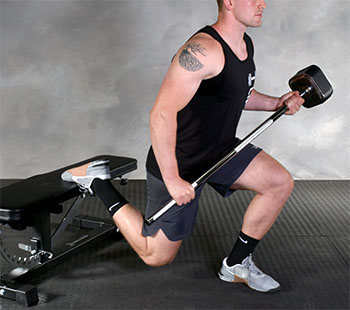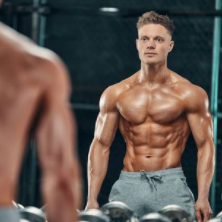Blog
When to Utilize Bilateral vs Unilateral Training
Pro Tips You Can Immediately Use In Your Training
When most people are given their first resistance programme many of the exercises will use both arms or both legs, known as bilateral training. This isn't necessarily a bad idea to build a base level of strength and co-ordination. However, once those foundations have been achieved, introducing single leg or arm exercise, known as unilateral training can offer up several interesting benefits.
Identifying Weak Muscles
We all have a stronger side. There's a hand you'll use to pick up the groceries and a foot you'll use to kick a ball, It's more common than not to have some asymmetry between sides of your body, both in size and strength. For example, you might be able to lift 30lbs on one leg but 35lbs on the other. A 5lb difference from one side to the other is nothing to lose sleep about but 15lbs? 20lbs? 25lbs? that might be something you need to work on.
When you have large strength deficits between sides, you might overcompensate when doing bilateral work. If you squat, you might find your hips shift to the side. During a bench press you might push one side up faster than the other potentially making it more dangerous as more weight lingers over the weaker side.
Whilst the body is very resilient and tends to adapt to the demands placed upon it, you may find exercise technique and efficiency is compromised when one side is significantly stronger than the other. More unilateral training can help with that.
Assessing Joint Range of Motio
Unilateral exercises are not only good for growing and strengthening muscles but also to assess what ranges of motion you can achieve. They're an exercise and fitness test in one.
It may be that you are unable to perform a particular movement bilaterally with the range of motion desired. Again, using the squat as an example, you might find you are unable to hit a comfortable depth without some restriction.
By performing unilateral movements you can test each side individually. As the saying goes, you are only as strong as your weakest link and if you lack the mobility on one side, you won't be able to perform a movement correctly with both legs.
This is quite common when someone has had an injury such as a sprained or broken ankle at a young age and never regained mobility. Unilateral exercises allow you to assess each side and put the necessary protocol in place to regain range of motion.
Bilateral Deficit
If you were to do a 1 rep max for each leg and add those numbers together generally speaking it will be more than if they did it with both legs. This is known as a bilateral deficit. Much like unilateral asymmetries, this is not uncommon but it does mean you might be able to get more out of your muscles by doing unilateral exercises.
For example, if you were squatting 200lbs for 10 reps you would be taxing each side with 100lbs. However, if you were to only do one leg, you might be able to achieve 110lbs for 10 reps.
You could argue that because both sides cannot produce exactly twice the force, by training each side individually, you are able to work them harder.
Contralateral Strength
One interesting and relatively unknown benefit of unilateral training is the ability to improve strength on the opposite side. This isn't particularly useful if you are training as normal but it is useful if one side becomes incapacitated.
You might think that because one side is out of action there is no point in training the other. Maybe you think your healthy side will get too big or too strong but research shows training one side can help the other. This is good news for those who want to bounce back from injuries faster as they won't need to make up as much of a strength loss compared to if they left both sides untrained.
Improved Athletic Performance
Unilateral exercises have been championed by sports coaches for decades. In many sports, you'll spend a lot of time driving off a single leg or using a single arm. Logically it makes sense to train unilaterally to practice some of those movements.
A recent systematic review and meta-analysis from Liao et al (2021) investigated the effects of bilateral vs unilateral resistance training interventions on various athletic outcomes.
They found that unilateral training was neutral to positive and particularly positive in the case of unilateral jump and change of direction. Therefore, if you play a sport that involves jumping off one leg or changing direction often, it might pay you to incorporate some unilateral work in your programming.
Pistol Squats and Single-Leg Squats
Pistol squats are the holy grail of unilateral exercises and are a display of physical prowess not too dissimilar to the muscle up for the upper body. They require great mobility (both in the hip and ankle), coordination, balance and muscular strength. If you can do a pistol squat, you can probably perform most movements comfortably.
Typically a pistol squat is performed with the non-standing leg out in front of you. However, by changing the non-standing leg position, you can alter the biomechanics of the movement. Khuu et al. (2016) showed how different positions of the non-standing leg led to changes in trunk, pelvic, hip and knee mechanics. As an example, putting the non-standing leg behind you caused the trunk to lean forward which would put an emphasis on different muscles compared to putting the leg in front of you.
With that being said, there is scant research on pistol squats effectiveness for hypertrophy, strength and sports performance. It's impossible to research every exercise and it seems the pistol squat is one of them. So whilst it is an impressive exercise and certainly wouldn't do any harm, we can't say for sure if it is better than other unilateral exercises for any application.
Top 5 Unilateral Exercises
Pistol Squat
If you were to crown a single unilateral exercise, it would probably be the pistol squat. Whilst it may not be the best muscle builder, it does represent a high skill level in several areas - strength, balance, co-ordination and mobility.
It might seem like an intimidating movement at first but there are ways to make it easier to build up to the full movement.
- Use a box or bench to squat to.
- Hold on to a pillar of a power rack with one hand to aid your stability.
- Use a suspension trainer to aid your balance.
Much like an assisted pull up or dip machine, over time, you want to reduce the amount of assistance you’re using.
Once you’ve achieved the full pistol squat, you can make it even harder by holiding a weight or performing off a box!
Single Arm Landmine Shoulder Press
The landmine attachment allows us to get into positions we wouldn’t normally be able to using traditional barbells and dumbbells.
A shoulder press using a landmine introduces a rotational challenge for the core that a dumbbell wouldn’t.
In my experience, it also tends to be more comfortable for most people compared to pressing directly over head. Especially those who lack good shoulder mobility.
Single Arm Chest Supported Cable Row
The great thing about cable rows is the ability to adjust the cable up and down to target different areas of the back. When performing a typical dumbbell row (which is still a great movement) you are limited with where the dumbbell goes as gravity is acting heavily on the dumbbell.
Adding in a chest support eliminates movement of the torso to stops you from “cheating” by using momentum to move the weight.
Offset Rear Foot Elevated Split Squat
Also known as the Bulgarian Split Squat, this movement is considered one of the toughest lower body movements. By elevating the rear foot, almost all the load is shifted to the standing leg.
Whilst you can also do this movement with two dumbbells, by only holding a single dumbbell, it frees up the other hand to hold onto something for stability. This allows you to truly focus on that leg rather than worrying about balance.

Single Arm Tricep Pushdown
Most tricep exercise will have both arms out in front which fixes the arms in place and limits free movement.
If you stand slightly offset to a cable machine you can allow the arm to move freely to your side and achieve a greater range of motion through shoulder flexion.
If you find you get elbow pain performing tricep exercises then using cables and performing them unilaterally means you can position your arm in such a way it doesn’t cause pain.
About the Author

Harry is an online personal trainer and WNBF men's physique professional from the UK. He's has been working in health & fitness for over a decade and has had almost every job the industry has to offer. From owning a private personal training studio to training Bollywood actors in India and now, coaching clients from all over the world online. Harry also started out competing in natural bodybuilding before transitioning to men's physique where he won the world championships in Las Vegas in 2021. Harry's primary interest is to take more nuanced and complex subjects related to health and fitness and make them more accessible for those who don't have the time to trawl through the research. When he's not in the gym, Harry enjoys going out for drinks with friends and getting his hands dirty with DIY (although preferably not at the same time!).

No Comments Yet